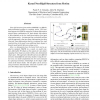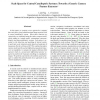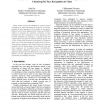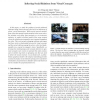133
click to vote
ICCV
2011
IEEE
14 years 1 months ago
2011
IEEE
Non-rigid structure from motion (NRSFM) is a difficult, underconstrained problem in computer vision. The standard approach in NRSFM constrains 3D shape deformation using a linear...
101
click to vote
ICCV
2011
IEEE
14 years 1 months ago
2011
IEEE
In this paper we propose a new approach to compute the scale space of any omnidirectional image acquired with a central catadioptric system. When these cameras are central they ar...
108
click to vote
ICCV
2011
IEEE
14 years 1 months ago
2011
IEEE
We present a method for reconstructing a trajectory of an object moving in front of non-overlapping fully or partially calibrated cameras. The non-overlapping setup turns that pro...
130
click to vote
ICCV
2011
IEEE
14 years 1 months ago
2011
IEEE
Linear subspace learning (LSL) is a popular approach to image recognition and it aims to reveal the essential features of high dimensional data, e.g., facial images, in a lower di...
127
click to vote
ICCV
2011
IEEE
14 years 1 months ago
2011
IEEE
Many recent works have attempted to improve object recognition by exploiting temporal dynamics, an intrinsic property of video sequences. In this paper, a new spatiotemporal hiera...
ICCV
2011
IEEE
14 years 1 months ago
2011
IEEE
We present two theses in this paper: First, performance of most existing face recognition algorithms improves if instead of the whole image, smaller patches are individually class...
119
click to vote
ICCV
2011
IEEE
14 years 1 months ago
2011
IEEE
In this paper, we study the problem of social relational inference using visual concepts which serve as indicators of actors’ social interactions. While social network analysis ...
108
click to vote
ICCV
2011
IEEE
14 years 1 months ago
2011
IEEE
With nearly one billion online videos viewed everyday, an emerging new frontier in computer vision research is recognition and search in video. While much effort has been devoted ...
146
Voted
ICCV
2011
IEEE
14 years 1 months ago
2011
IEEE
We present an approach for dictionary learning of action attributes via information maximization. We unify the class distribution and appearance information into an objective func...
ICCV
2011
IEEE
14 years 1 months ago
2011
IEEE
We consider the problem of quantizing data generated from disparate sources, e.g. subjects performing actions with different styles, movies with particular genre bias, various con...








